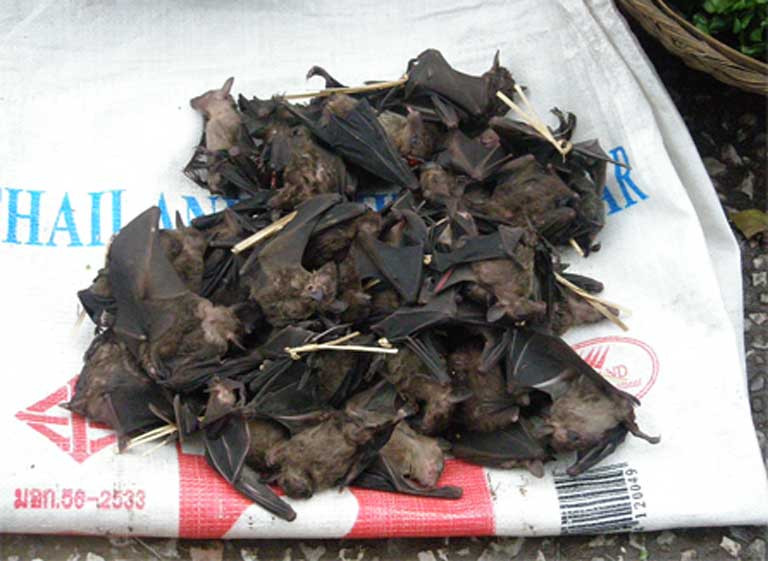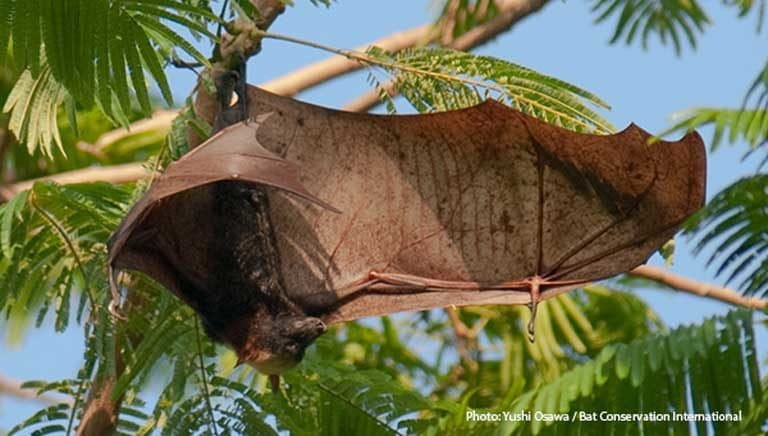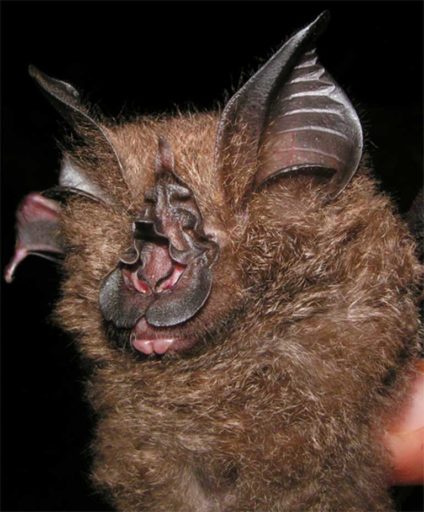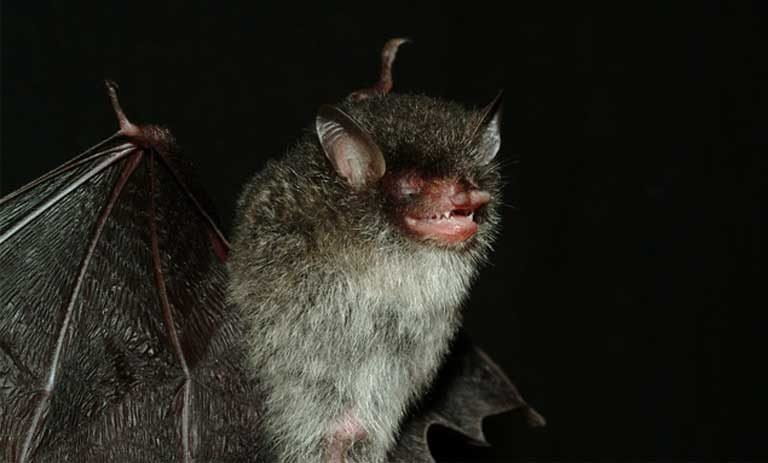- Asia boasts 442 bat species, more than a third of the globe’s 1,200 species total. While many of these bats haven’t even been assessed by the IUCN, 7 are known to be Critically Endangered, 15 are Endangered and 44 are Vulnerable.
- The bumblebee bat roosts in caves in Thailand and Myanmar. While population estimates have risen recently due to the discovery of new populations, this small bat is Vulnerable. Its roosting caves and forest habitat are being disrupted by people.
- Bats worldwide are understudied and also unloved, partly due to poor public perceptions perpetuated by hundreds of horror movies with their portrayals of bloodsucking bats. The truth is that bats are incredibly beneficial to humans, eating prodigious amounts of insect pests.
- One of the most fascinating facts about the bumblebee bat is that its two geographically separated populations in Thailand and Myanmar might currently be undergoing speciation, a process scientists would like to observe. Of course, that won’t happen if nothing is done to keep this tiny mammal from going extinct.

It’s a hummingbird… it’s a bumblebee… it’s Kitti’s hog-nosed bat. Yes, seriously, look at it: it’s a bat. A teensy, tiny, teeny, weeny bat.
Kitti’s hog-nosed bat (Craseonycteris thonglongyai) is debatably the world’s smallest mammal and most definitely the world’s smallest bat. Informally known as the bumblebee bat, Kitti’s hog-nosed bat is about the size of a large bumblebee, weighing in at just two grams — about the weight of two Skittles. Again, seriously. It’s also just one of around 440 bat species found in Asia — a continent that houses more than one third of the world’s 1,200 bat species.
“It is [an] incredibly tiny creature — even smaller than my thumb (though I have small hands already),” researcher Pipat Soisook told Mongabay.
A well-known bat expert (a chiropterologist), Soisook is the mammal curator at the Princess Maha Chakri Sirindhorn Natural History Museum in Thailand, one of only two countries where Kitti’s hog-nosed bat, or the bumblebee bat, lives. Myanmar is the other.
Soisook has had the pleasure of seeing many bumblebee bats in the wild, where they generally live in small colonies; they refrain from crowding together like many other bat species. When you see the bats in a cave, he said, these miniature mammals “just look like black spots on the cave wall, and you may not realize they are actually bats without going in close enough.”

Even museum specimens of the species impress. Emma Teeling, with University College Dublin, said that when she has examined species specimens she “was blown away by its perfection and small size.”
The bumblebee bat is important for another reason: it’s utterly unique. This single species alone represents an entire family of bats, the Craseonycteridae, which split from the rest some 33 million years ago.
Downlisted, with caveats
For 12 years, the bumblebee bat was listed as Endangered by the IUCN Red List, but in 2008 it was downlisted to Vulnerable due in part to the discovery of new populations, including ones across the Thai border in Myanmar.
Surveys from 1997-2008 counted around 10,000 bats in 44 caves in western Thailand and five caves in Myanmar. The total population may be considerably higher, however, with researchers estimating the Thai population at around 45,000 individuals in a 2009 study presented in the journal Endangered Species Research.
No one knows how many might live in Myanmar, since a more thorough survey there could not be conducted due to security issues. But experts believe the Myanmar population is probably quite small due to the bat’s specific microhabitat requirements.
While these new higher population estimates are good news for the planet’s tiniest bat, caveats remain. Scientists believe that the populations in Myanmar and Thailand are not geographically interconnected, with both genetic and echolocation research showing them to be quite different from each other. The two groups may even represent separate subspecies or species. If that is determined to be the case someday, then the new population total would need to be split into two unequal parts. Soisook, however, goes on to point out that the Myanmar and Thai bat populations — while separated by topography — are still presently morphologically (physically) alike.
“We probably cannot assign them as [being] different species [as yet], but we know that they are at least under an ongoing speciation process,” he explained. That, in itself,
presents scientists with a fascinating opportunity: they may be able to study a mammal undergoing the split into two species, or subspecies. But for that to happen, of course, conservationists need to insure neither population vanishes.

As go the bat caves, so go the bumblebee bats
This tiny bat is threatened by human disruptions both inside its roosting caves, and in the forests where it forages. Conservationists say that monks using the caves for meditation, drug users escaping to caves for a fix, and tourists driven by the desire to see the bats, have all negatively impacted the species. Indeed, some grottos have been turned into “show caves,” leading to the destruction of bat habitat.
“Ecotourism should be fine when tourists do not destroy or modify natural habitat,” explained Soisook. “However, in most cases, when promoting a cave as a tourist attraction [guides] usually modify the cave to make it more comfortable for the tourists.”
If tourists venture into the caves to see the bats, then some impact is unavoidable, according to Soisook. The best way to mitigate this damage, he added, is to only allow tourists into “some big caves where human activities will not change micro-habitat much.” The number of tourists allowed into the various caves should also be regulated.
He noted that smoke inside the caves — whether from meditating monks or drug users — could significantly harm the bats. One small piece of good news: in Myanmar, monks have become cave protectors. The monks usually only use the cave entrances, and their presence tends to keep others away, including hunters, drug addicts and even mining companies that would destroy the caves for cement production.
The bat, which was only discovered by scientists in 1974, has also been impacted by scientific collection, and also by their sale as souvenirs to tourists willing to pay for them.
Outside the caves, rapid deforestation due to logging, agricultural expansion and the growth of human communities, remains the major conservation concern, a reality for many vanishing species all across Asia.
The bumblebee bat is legally protected in Thailand, and a portion of its habitat is protected by parks. But much more needs to be done to adequately conserve the species. Conservationists have recommended improved protection and management of its roosting caves as well as broader protection of its foraging areas.

Asia’s 400+ other bats
Asia is home not only to the smallest bat, but the largest too. Found in the Philippines, the golden-crowned flying fox (Acerodon jubatus) is not just a juggernaut HOW BIG IS IT?, but is one of the continents’ most threatened bats, currently listed as Endangered. And it is not alone.
Of the 442 Asian bat species assessed by the IUCN Red List, seven are listed as Critically Endangered, 15 as Endangered, and 44 as Vulnerable. This means 14 percent of bats on the continent are currently considered threatened. But that is likely a major underestimate.
Seventy-one species (16 percent) of bats in Asia are listed as Data Deficient — more than all the species listed as threatened. Data Deficient simply means that scientists don’t know enough about these species to make an accurate assessment. Unfortunately, such statistics are not an anomaly when it comes to bats.

Ongoing research by Jessica Welch, a PhD student at the University of Tennessee, has determined that nearly 200 species of bat are listed as Data Deficient worldwide and, even more will likely be added to that list — 168 additional species have yet to be evaluated at all by science.
Micaela Jemison, the Director of Communication at Bat Conservation International, an NGO, observed that “we know relatively little” about bats in general, including species in Asia. “Bats are one of the hardest species to monitor, with their often cryptic natures and ability to fly long distances.”
Why we don’t love ‘em, but why we need ‘em
Bats also suffer from a low public profile, and, sadly, from a negative public image largely due to extreme misinformation (think Horror films and blood-sucking vampire bats). As a result, these highly beneficial species — they eat prodigious quantities of insect pests — see little conservation funding compared to many other mammals.
Our ignorance about bats extends to whether their populations are rising or falling worldwide. According to Welch, 635 species of bat lack a trend-line, making establishing conservation priorities incredibly difficult. Welch is currently working on a project to help identify bats in need of more immediate conservation attention.
“I prioritize bats for future research according to the estimated research effort [giving more attention to less studied bats, for example], extinction risk, and evolutionary distinctiveness (i.e., how ‘different’ they are from related species given shared ancestry),” she wrote in an email to Mongabay, noting that her project findings will be ready for publication in 2017.
In Asia, bats are facing many of the same threats as other mammals: especially habitat loss and overhunting.

“Deforestation and the loss of associated roosting and foraging habitat is a major threat to Asian bats, as some countries have lost more than 80 percent of their primary forest cover due to over-exploitation of timber and land conversion for agriculture,” noted Jemison, who added that “bats in the region are also at risk from hunting for local consumption or for shipment to other countries where bat meat is considered a rare delicacy.”
Part of Bat Conservation International’s mission is to change the perceptions of bats by relying on hard numbers that show how important bats are to the environment and local economies, and then relaying those facts to the public.
“In Southeast Asia, bats are the farmers of the rainforests that many communities rely on,” Jemision explained. “Fruit bats are important seed dispersers for rainforest environments, moving seeds over cleared areas where birds and other mammals don’t dare venture. Many nectar-feeding bats are critical pollinators for a wide variety of plants of great economic and ecological value.”
Insectivore bats play a major role in pest control in the region, she said, citing research on the cacao industry in Indonesia. “Without bats, the cacao yield would be reduced by 22 percent. At today’s market cost, [that] would be a loss of $832 million to the industry!”
Sometimes, it’s good to be small
In many ways, the bumblebee bat is lucky compared to other Asian bats. It has been the focus of a number of studies, and scientists have a general idea of how it’s faring. This can be attributed to its teensy, tiny, teeny, weeny-ness: which has captured the imagination of scientists, conservations and even the public.
Many other Asian bats — including Critically Endangered species — remain little known and little protected on the continent. This is probably best highlight by the fact that new bats are still being discovered around Asia with some regularity.

Just last year, Soisook led a team that uncovered a new species of bat from Borneo and Thailand. Dubbed Francis’ woolly horseshoe bat (Rhinolophus francisi), the species was first collected in 1983, but it took more than twenty years for anyone to realize it was an as-yet undescribed species.
R. francisi has not yet been assessed by the IUCN Red List, but it’s very likely threatened and maybe near extinction: Francis’ woolly horseshoe bat has only been recorded by researchers six times.
If Asia’s bats — including Francis’ woolly horseshoe bat, the golden-crowned flying fox, and, of course, the bumblebee bat – are to survive, then they urgently need to be given more attention. Research and funding must target their conservation specifically.
The world needs to learn to love bats, from the smallest to the largest, and it needs to cultivate that love affair with these misunderstood creatures of the night now.
Citations:
Maas, Bea, Yann Clough, and Teja Tscharntke. “Bats and birds increase crop yield in tropical agroforestry landscapes.” Ecology letters 16, no. 12 (2013): 1480-1487.
Puechmaille, Sébastien J., Pipat Soisook, Medhi Yokubol, Piyathip Piyapan, Meriadeg Ar Gouilh, Khin Mie Mie, Khin Khin Kyaw et al. “Population size, distribution, threats and conservation status of two endangered bat species Craseonycteris thonglongyai and Hipposideros turpis.” Endangered Species Research 8, no. 1-2 (2009): 15-23.
Puechmaille, Sébastien J., Meriadeg Ar Gouilh, Piyathip Piyapan, Medhi Yokubol, Khin Mie Mie, Paul J. Bates, Chutamas Satasook et al. “The evolution of sensory divergence in the context of limited gene flow in the bumblebee bat.” Nature Communications 2 (2011): 573.
Soisook, Pipat, Matthew J. Struebig, Sephy Noerfahmy, Henry Bernard, Ibnu Maryanto, Shiang-Fan Chen, Stephen J. Rossiter et al. “Description of a new species of the Rhinolophus trifoliatus-group (Chiroptera: Rhinolophidae) from Southeast Asia.” Acta Chiropterologica 17, no. 1 (2015): 21-36.
